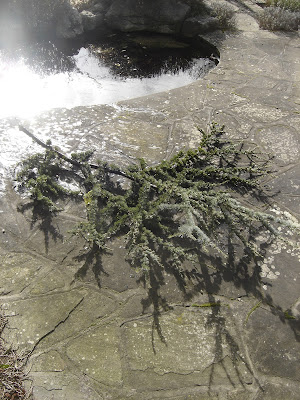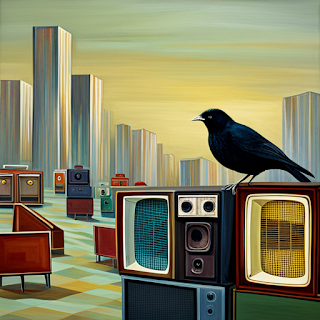Deleted Notes & Queries response: What happens to the soil under heavily concreted environments?
(The Guardian jannies have struck down my Notes & Queries response for being in breach of community standards. I think the most-likely reason is the passing mention of Russia, which is enough to spread disquieting, PTSD-inducing ripples across the surface of an almond milk latte in the rarefied air of redeveloped King Cross. Anyway here it is if you want to read it)
~
I don't think I am divulging any state secrets when I say that Richard Pilbrow's cold war career in the diplomatic service went hand in hand with a certain amount of intelligence gathering. He published a book about his experiences in 2019. I would assume that anything sensitive in nature was redacted by the blinders of the Whitehall publishing arm, who are the only buyers for this kind of memoir.
A couple of months ago, at Richard's request, I paid a visit to his home in Barnes, to witness him signing some legal paperwork. His study was a small, dim-lit room, screened off from the world behind heavy lace curtains, and overwhelmed with clutter. Decorating the wall pillars, on either side of the window, were two framed pieces of abstract art. The one on the left was a quartet of fuzzy rectangles, rendered in muddy tones of green and grey – Mark Rothko meets Andy Warhol on a foggy morning. The other was a sun-faded marble pattern, almost as drab as its partner but with a greater variation of muted colours. Initially I mistook it for the kind of computer-generated imagery that might, if stared at long enough, yield an image of a seagull in flight, or the QE2.
While Richard was in conference with his lawyer, I was able to subject both works to closer scrutiny, after-which I concluded that they were aerial photographs of poor quality.
“Oh that's um, that's interesting,” remarked Peter, when I raised his art collection as a topic of discussion. The conversation might well have ended there had I not requested further detail:
“These are the before and after images of one of those Soviet science cities that they used to build in the back of beyond; Siberia and other out of the way places,” he explained. “No name or designation. Completely invisible to bureaucracy. They concreted over a patch of ground and put up some laboratory buildings and a military garrison. We called it “Kew Gardens” on account of this green parade ground. It seemed to change colour and we could never work out why. Were they painting it? Were they testing out aerial camouflage? Eventually we received some field intelligence; the kind that gets filed under 'interesting but useless': The lichen on the tundra had come up through the grain of the concrete. It was photosensitive. When the light began to fade, it would withdraw into the tiny holes, hence the changes in colour. At night it would emit a faint, chalky glow. The same source told us that, following the appearance of the lichen, this area was designated a park. It's hard to tell whether that was Soviet humour, or the sincere conclusion of a committee that was formed to discus the matter.”
“Someone's drawn the outline of a tree,” I said, tapping an area of the glass where a pair of faint parallel lines flared outwards at one end to form a trunk. At the opposite end there was a wavy blob representing the leaf canopy.
“Goodness, I never noticed that before,” said Richard. “Somebody expressing a modicum of free thought. Let's hope they didn't pay too high a price.”
Moving to the second picture, he continued his monologue:
“It was photographed by Norwegian intelligence approximately every fortnight. Then, in the space of two weeks, the entire city vanished. Buildings razed. Foundations uprooted. In their place were all these green, orange, and purple patches. This is the lichen that couldn't penetrate the concrete. The surface lichen was filtering light underground in exchange for wet phosphates. A symbiotic relationship. I've heard it called a barrier ecosystem. It's quite common in urban areas these days.”
Of course, not every concreted area fares so well. Shortly after lockdown, I accompanied Robyn Dixon and her daughter Adeline, on a walk along a stretch of canal, near their home in Rushgill.
To their collective horror, a meadow that had, until recently, been a towpath pen, where the horses who once worked on the canal were rested, had been developed into a car-park for an adjacent pub. The meadow was previously home to purple flowers, called baisers du sol, whose blossoms naturally bend down to touch the soil. They are pollinated by ants who also keep the plants free from pests. Adeline, who was apparently permitted to pick a small bouquet on Mothering Sunday, wanted to know where the flowers had gone. Her mother, who is used to dealing with such crises, informed her they had been taken to Mortley's Garden Centre.
The little girl's concern shifted to the ants who had been buried underneath the concrete. How would they get out? Spying a drinking straw that had evidently been run over several times, I told her that the workmen had used straws to make tunnels. Robyn and I both agreed that the ants were doing well on a diet of discarded chips and sugar packets.
It was through this well-meant web of deceit that Adeline's tears for the absent insect and plant-life were, if not completely averted, then at least saved for another day.
I hope this is of help.




Comments
Post a Comment